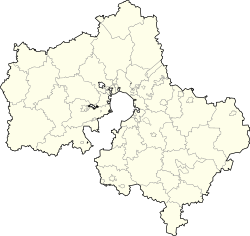Korolyov, Moscow Oblast
Korolyov
Королёв | |
|---|---|
 Entrance to the city (April 2013) | |
| Coordinates: 55°55′N 37°49′E / 55.917°N 37.817°E | |
| Country | Russia |
| Federal subject | Moscow Oblast[1] |
| Founded | 26 December 1938 |
| City status since | 1938[2] |
| Government | |
| • Head[3] | Trifonov, Igor Vladimirovich[3] |
| Area | |
| • Total | 55.47 km2 (21.42 sq mi) |
| Elevation | 160 m (520 ft) |
| Population | |
| • Total | 183,402 |
| • Estimate (2018)[5] | 222,952 (+21.6%) |
| • Rank | 98th in 2010 |
| • Density | 3,300/km2 (8,600/sq mi) |
| • Subordinated to | Korolyov City Under Oblast Jurisdiction[1] |
| • Capital of | Korolyov City Under Oblast Jurisdiction[1] |
| • Urban okrug | Korolev Urban Okrug[6] |
| • Capital of | Korolev Urban Okrug[6] |
| Time zone | UTC+3 (MSK |
| Postal code(s)[8] | 141060, 141062, 141065, 141067–141071, 141073–141080, 141089, 994009 |
| OKTMO ID | 46734000001 |
| Twin towns | Zhukovsky |
| Website | korolev |
Korolyov or Korolev (Russian: Королёв, IPA: [kərɐˈlʲɵf]) is an industrial city in Moscow Oblast, Russia. It is well known as the cradle of Soviet and Russian space exploration. As of the 2010 Census, its population was 183,402, the largest as a science city.[4] As of 2018, the population is more than 222,000 people.
It was known as Kaliningrad (Калинингра́д) from 1938 to 1996. It was the leading Soviet center for the making of anti-tank and air-defense guns. In 1946, in the aftermath of World War II, the artillery plant was reconstructed for the making of rockets, launch vehicles, and spacecraft.
Russian Mission Control Center is also located in Korolyov. Though the real control is decentralized due to security reasons and all space aircraft may be controlled from many different locations across Russia, the historic center of control is still in Korolev, and is called FCC - Flights Control Center.
In July 1996, the city was renamed in honor of Sergei Korolev, the father of the Soviet/Russian space program, who died in 1966. Since 1997, Korolyov has hosted the International Space Olympics, an annual competition for young people to promote space research.
Demographics[change | change source]
As of 1 January 2016, Korolyov was in 93rd out of 1112 cities in Russia based on demographics.
On 2 June 2014, the city of Yubileniy officially became a part of Korolyov. With a total population of 220 thousand people,[9] Korolyov became the third largest city in Moscow Oblast based on population after Balashikha (428,400[9]) and Khimki (239,967[9]).
Twin towns and sister cities[change | change source]
Korolyov is twinned with:
References[change | change source]
- ↑ 1.0 1.1 1.2 1.3 Law #11/2013-OZ
- ↑ Encyclopædia Britannica. Entry on Korolyov
- ↑ 3.0 3.1 http://www.korolev.ru.
{{cite web}}: Missing or empty|title=(help) - ↑ 4.0 4.1 Всероссийская перепись населения 2010 года. Том 1 [2010 All-Russian Population Census, vol. 1]. Всероссийская перепись населения 2010 года (2010 All-Russia Population Census) (in Russian). Federal State Statistics Service. 2011. Retrieved June 29, 2012.
- ↑ "26. Численность постоянного населения Российской Федерации по муниципальным образованиям на 1 января 2018 года". Federal State Statistics Service. Retrieved 23 January 2019.
- ↑ 6.0 6.1 Law #53/2014-OZ
- ↑ "Об исчислении времени". Официальный интернет-портал правовой информации (in Russian). 3 June 2011. Retrieved 19 January 2019.
- ↑ Почта России. Информационно-вычислительный центр ОАСУ РПО. (Russian Post). Поиск объектов почтовой связи (Postal Objects Search) (in Russian)
- ↑ 9.0 9.1 9.2 Всероссийская перепись населения 2010 года. Том 1 [2010 All-Russian Population Census, vol. 1]. Всероссийская перепись населения 2010 года (2010 All-Russia Population Census) (in Russian). Federal State Statistics Service. 2011. Retrieved June 29, 2012.





